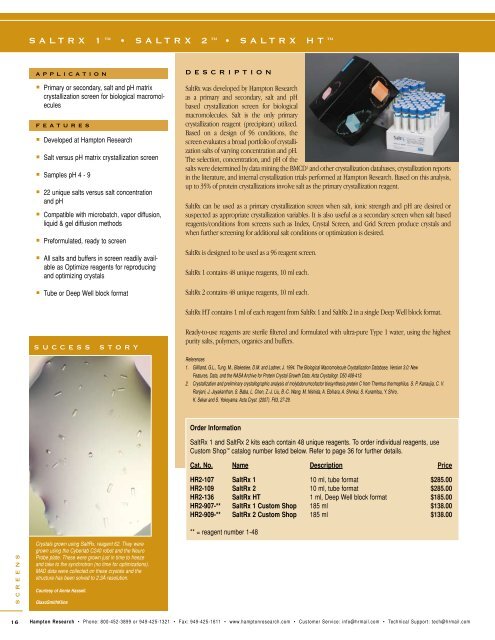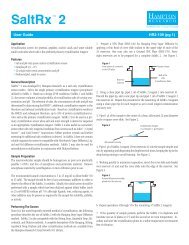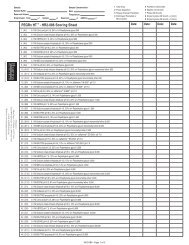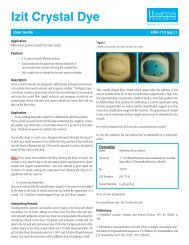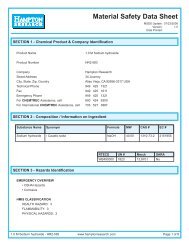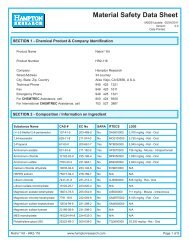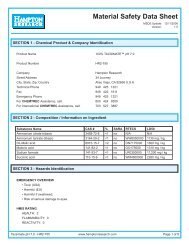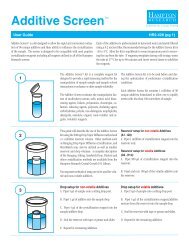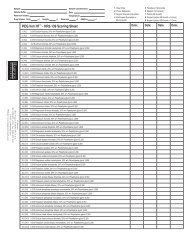Download - Hampton Research
Download - Hampton Research
Download - Hampton Research
Create successful ePaper yourself
Turn your PDF publications into a flip-book with our unique Google optimized e-Paper software.
SaltRx 1 • SaltRx 2 • SaltRx HT<br />
application<br />
n Primary or secondary, salt and pH matrix<br />
crystallization screen for biological macromolecules<br />
features<br />
n Developed at <strong>Hampton</strong> <strong>Research</strong><br />
n Salt versus pH matrix crystallization screen<br />
n Samples pH 4 - 9<br />
n 22 unique salts versus salt concentration<br />
and pH<br />
n Compatible with microbatch, vapor diffusion,<br />
liquid & gel diffusion methods<br />
n Preformulated, ready to screen<br />
n All salts and buffers in screen readily available<br />
as Optimize reagents for reproducing<br />
and optimizing crystals<br />
n Tube or Deep Well block format<br />
description<br />
SaltRx was developed by <strong>Hampton</strong> <strong>Research</strong><br />
as a primary and secondary, salt and pH<br />
based crystallization screen for biological<br />
macromolecules. Salt is the only primary<br />
crystallization reagent (precipitant) utilized.<br />
Based on a design of 96 conditions, the<br />
screen evaluates a broad portfolio of crystallization<br />
salts of varying concentration and pH.<br />
The selection, concentration, and pH of the<br />
salts were determined by data mining the BMCD 1 and other crystallization databases, crystallization reports<br />
in the literature, and internal crystallization trials performed at <strong>Hampton</strong> <strong>Research</strong>. Based on this analysis,<br />
up to 35% of protein crystallizations involve salt as the primary crystallization reagent.<br />
SaltRx can be used as a primary crystallization screen when salt, ionic strength and pH are desired or<br />
suspected as appropriate crystallization variables. It is also useful as a secondary screen when salt based<br />
reagents/conditions from screens such as Index, Crystal Screen, and Grid Screen produce crystals and<br />
when further screening for additional salt conditions or optimization is desired.<br />
SaltRx is designed to be used as a 96 reagent screen.<br />
SaltRx 1 contains 48 unique reagents, 10 ml each.<br />
SaltRx 2 contains 48 unique reagents, 10 ml each.<br />
SaltRx HT contains 1 ml of each reagent from SaltRx 1 and SaltRx 2 in a single Deep Well block format.<br />
success story<br />
Ready-to-use reagents are sterile filtered and formulated with ultra-pure Type 1 water, using the highest<br />
purity salts, polymers, organics and buffers.<br />
References<br />
1. Gilliland, G.L., Tung, M., Blakeslee, D.M. and Ladner, J. 1994. The Biological Macromolecule Crystallization Database, Version 3.0: New<br />
Features, Data, and the NASA Archive for Protein Crystal Growth Data. Acta Crystallogr. D50 408-413.<br />
2. Crystallization and preliminary crystallographic analysis of molybdenumcofactor biosynthesis protein C from Thermus thermophilus. S. P. Kanaujia, C. V.<br />
Ranjani, J. Jeyakanthan, S. Baba, L. Chen, Z.-J. Liu, B.-C. Wang, M. Nishida, A. Ebihara, A. Shinkai, S. Kuramitsu, Y. Shiro,<br />
K. Sekar and S. Yokoyama. Acta Cryst. (2007). F63, 27-29.<br />
Order Information<br />
SaltRx 1 and SaltRx 2 kits each contain 48 unique reagents. To order individual reagents, use<br />
Custom Shop catalog number listed below. Refer to page 36 for further details.<br />
Cat. No. Name Description Price<br />
HR2-107 SaltRx 1 10 ml, tube format $285.00<br />
HR2-109 SaltRx 2 10 ml, tube format $285.00<br />
HR2-136 SaltRx HT 1 ml, Deep Well block format $185.00<br />
HR2-907-** SaltRx 1 Custom Shop 185 ml $138.00<br />
HR2-909-** SaltRx 2 Custom Shop 185 ml $138.00<br />
** = reagent number 1-48<br />
screens<br />
Crystals grown using SaltRx, reagent 62. They were<br />
grown using the Cyberlab C240 robot and the Neuro<br />
Probe plate. These were grown just in time to freeze<br />
and take to the synchrotron (no time for optimizations).<br />
MAD data were collected on these crystals and the<br />
structure has been solved to 2.3Å resolution.<br />
Courtesy of Annie Hassell.<br />
GlaxoSmithKline<br />
16<br />
<strong>Hampton</strong> <strong>Research</strong> • Phone: 800-452-3899 or 949-425-1321 • Fax: 949-425-1611 • www.hamptonresearch.com • Customer Service: info@hrmail.com • Technical Support: tech@hrmail.com


